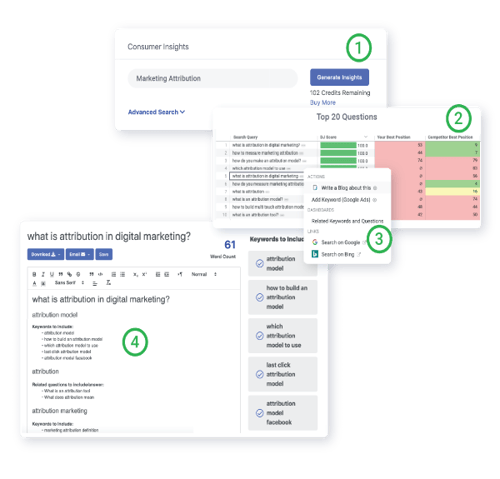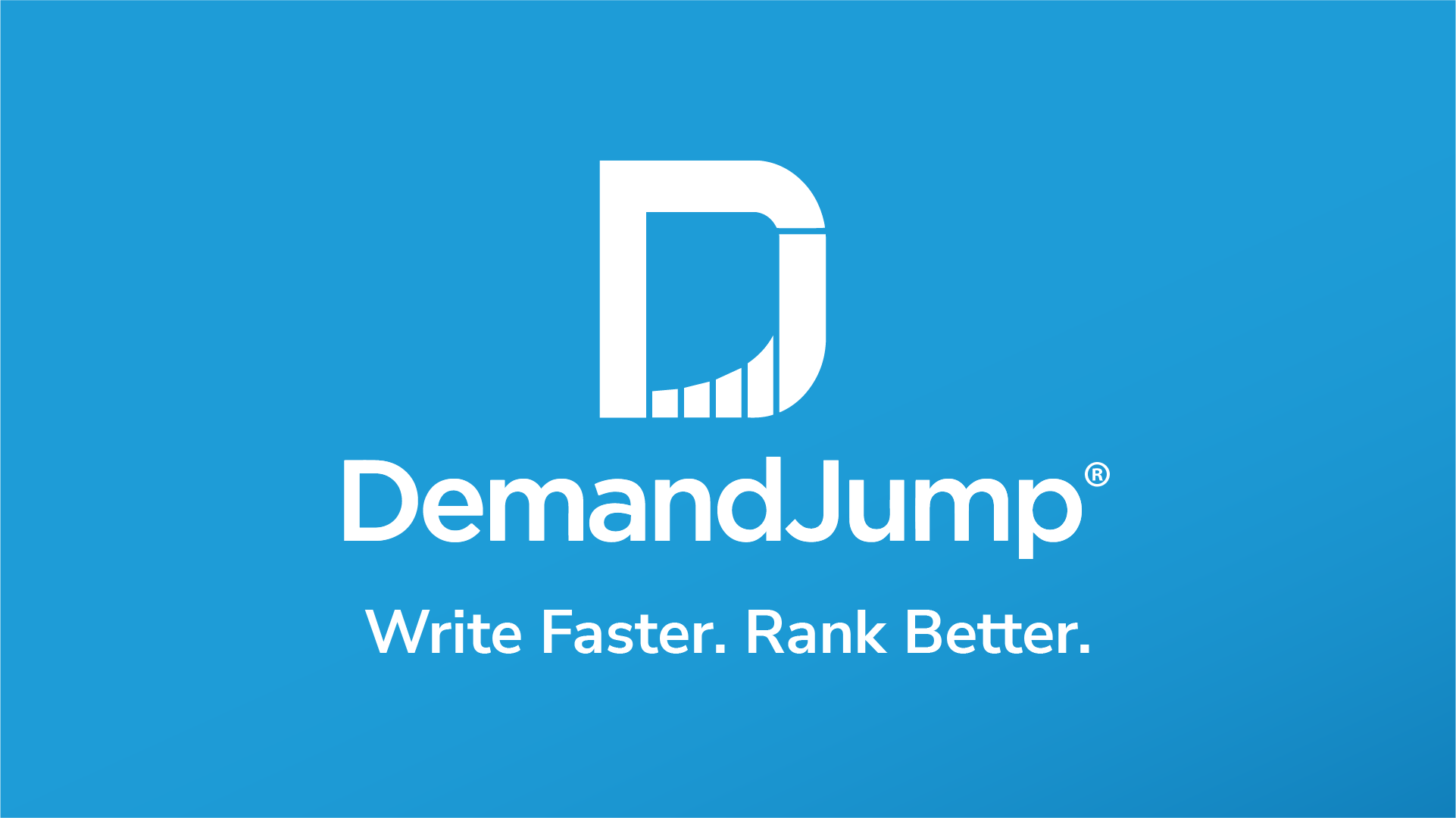See Insights in Action
By embracing DemandJump's approach to SEO, we have been able to increase our organic rankings within just 2 weeks of implementing recommendations. This helped us see a 22% increase in organic search month-over-month.
Robert Jacko Vice President Digital Marketing @ Homage
DemandJump has become a crucial extension of our marketing team, providing game changing insights to fuel and propel all aspects of our digital marketing efforts. The DemandJump platform is a must have, we are seriously impressed.
Tim Lavinder Director of Ecommerce @ Hotsox
We used to spend hours looking for insights in dozens of tools and reports. Now we log into one place to find out what customers are doing and how to meet them where it matters most.
Zach Roop Digital Marketing Manager @ Dometic
We use DemandJump recommendations as our digital to-do list. We love going in and seeing the recommendations and knowing what to do next.
JoLynda Wilson Marketing Director @ IWC
Trusted by Brands Around the World
What content is best for my target customer?
DemandJump reveals the online activity of consumers in your target audience and gives you a prioritized list of the top questions being asked about your specific products and services. Build your content strategy to align with trending topics, anticipate consumer questions, and drive action from your landing pages.
- Content Strategy Template
- Consumer Insights
- Blog & Content Creation Guide
- Product & Landing Page Content Ideas
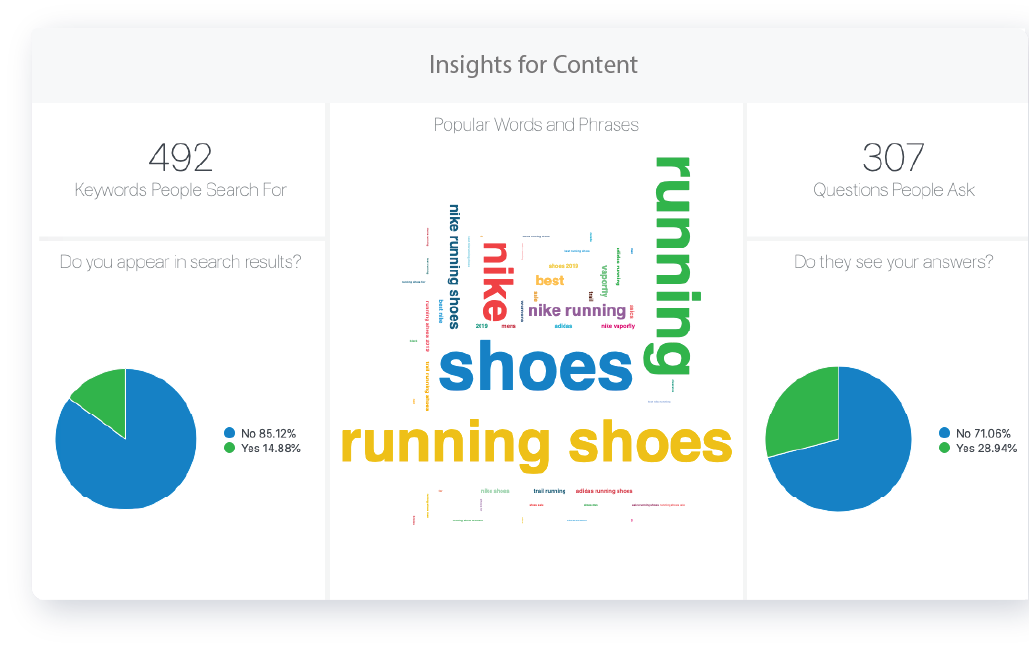
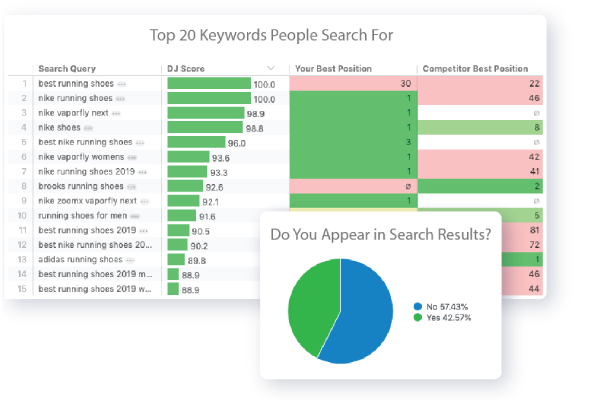
How do I align my search strategy with consumer intent?
Start with a prioritized list of the exact keywords on which you should focus. Next, create engaging ad copy that helps drive consumer decision making. Then place your ads on the top websites used by consumers along their path to purchase when they are in research, decision, and buy mode.
- Keyword Research Tool
- Ad Copy Generator
- SEO Content Creation
- Identify Backlink Opportunities
How can I align my programmatic ads to the consumer journey?
Effective display ads should live along a consumer’s path to purchase. See the sites they’re most likely to visit when researching your or your competitor’s products so you can places ads directly on the channels that appear most often to your target audience.
- Display Ad Placement Plan
- Custom Audience Creation
- Find Video Influencers
- Video Ad Placement Opportunities
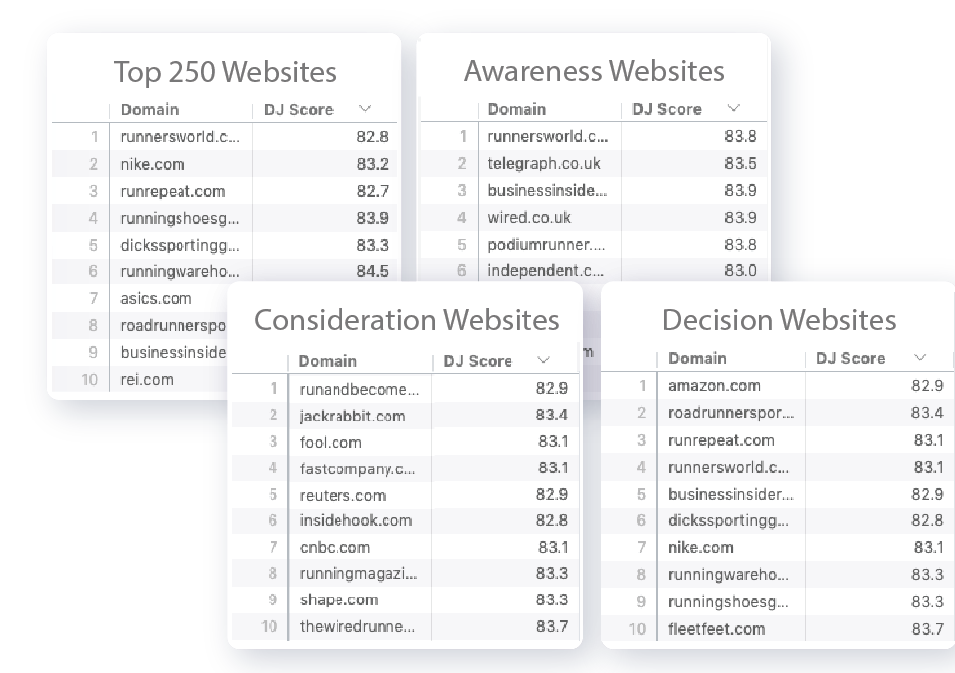
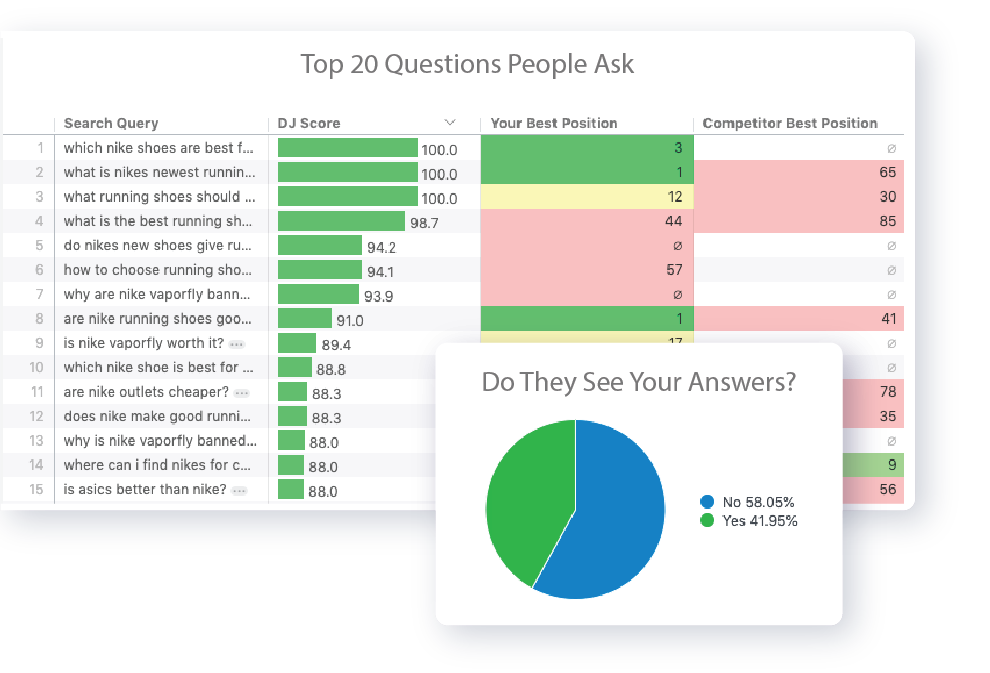
How do I set my brand apart from the competition?
Find out what people think about your brand. Once you know how they feel about your products or services, you can adjust your campaigns accordingly. Use side by side competitor ranking to see who’s leading in share of voice and uncover new ways to outmaneuver them.
- Brand Sentiment Tracking
- Brand Positioning Strategy
- Share of Voice Analysis
- Competitive Positioning Strategy
How can consumer behavior impact product strategy?
When you know how consumers actually behave online, you can arm your product development team with an organized checklist. Use those search queries to anticipate the buyer’s needs and then develop products that cater directly to them.
- Product Development Ideas
- Product Naming Conventions
- Align to Customer Needs
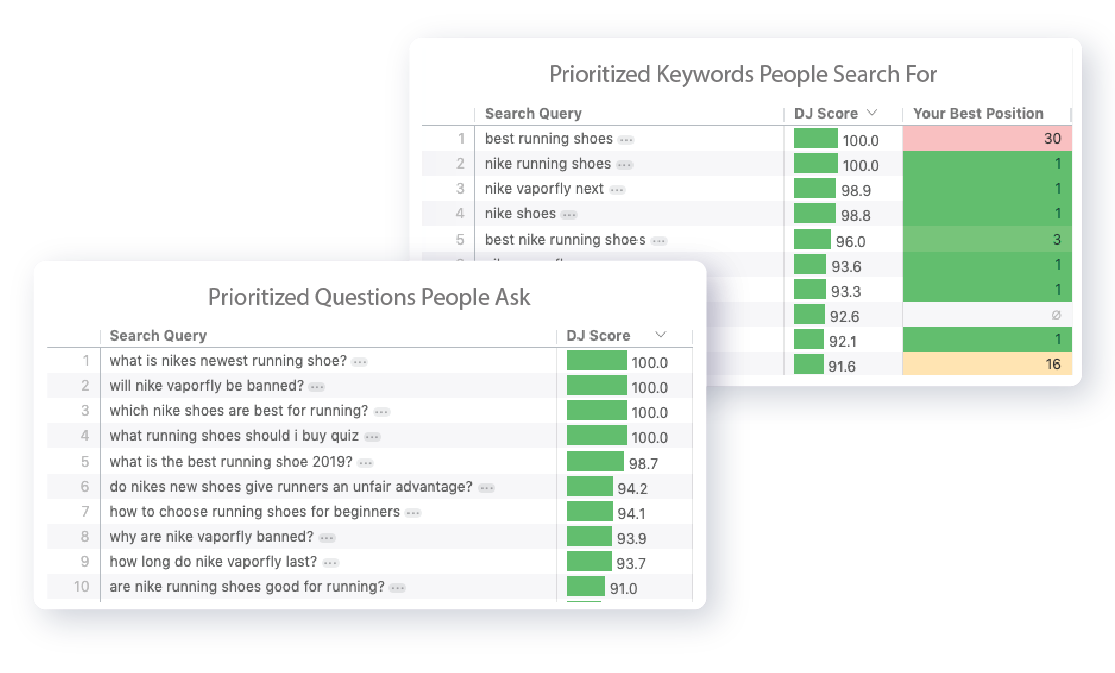
Get Free Consumer Insights Now
Smart companies are looking to collect consumer insights and customer insights in order to better understand their target market. While it may sound easy on paper, you may be asking yourself 'How do you gather customer insights?', 'How do you track consumer behavior?', or 'Why are customer insights important?'. Well, you would not be alone. The simple answer is DemandJump’s consumer insights platform. Consumer Insights uncover insights into your target audience’s true path-to-purchase. You no longer have to lose sleep trying to figure out how to find consumer insights. With these insights, you see what websites they visit, what searches they conduct, what questions they ask, and the videos and content they engage with when researching and buying products like yours.
How are consumer insights obtained?
Developing consumer insights from your data set can seem daunting, luckily there are tools out there to do the work for you. In order to obtain consumer insights, simply enter any topic or phrase into DemandJump’s consumer insights product and you’ll immediately gain access to all the search queries, websites, videos, and content that matters to consumers when they are researching that topic.

You can gather these insights on any topic or product category that your brand fits into, and you can gather insights on any number of phrases you think your target audience is searching. For example, if you are an eCommerce website that sells indoor plants, type into the search bar, “indoor plants” or “house plants”.
What you’ll get back is a snapshot of the online buyer journey that you can use to build your content strategies, structure your website optimized for search engines, make videos that answer consumer questions, and partner with the websites that your target audience frequently navigates. With these insights, you obtain a go-to-market playbook for meeting your target audience in the moment it matters, when they’re ready to buy. We have discussed how the platform informs on consumer behavior, but why is consumer behavior so important to marketers?
How do you use consumer insights?
Optimize your display advertising campaigns
DemandJump’s consumer insights highlight the websites consumers visit when they’re researching any topic or phrase. By understanding where consumers go when they’re in the mindset to buy products like yours, you can increase performance because you’ve met them in the right place and time. When looking at this dashboard, you get instant access to a list of sites where your display ads will perform best. This allows you to determine where to best allocate your budget on digital. Consumer Insights have helped companies in all industries drive higher value conversions by allowing them to get in front of consumers at the right time.
Build your search campaigns around actual consumer search behavior
These insights show you all the most relevant searches consumers make in search engines around your product category. If you’ve ever been unsure of what keywords to target, this consumer behavior dashboard is your answer. Simply type in a topic or phrase, and you’ll get a prioritized list of keywords you should test with your ads. You will be able to see the google customer journey that your target audience is taking on the path to purchase - the questions they ask, topics they search, and videos they watch. With DemandJump's google ad insights you will receive AI powered recommendations to improve ROI.
Write content your audience actually wants to read
One component of DemandJump’s consumer insights product is the sharing of questions your target audience is asking search engines. The platform analyzes this consumer behavior and cross references it with a variety of other sources to show you what questions really matter to your target personas. With this list of prioritized questions, you can take each question and build it into your content plan. Simply said, this list of questions can become your content checklist for the coming months.
Make videos that consumers want to watch
This consumer behavior analysis uncovers the videos your ideal consumer discovers and interacts with along their path to purchase. This creative insight example is a list of prioritized videos made by both your competitors and other content creators acts as great inspiration for what type of video content your team should be creating. Take this list of videos, watch them, and see what works for others in your industry.
Access a consumer journey map to inform your content funnel
In another dashboard within the Consumer Insights product, our platform breaks out these questions and searches into segments of the buyer journey: from awareness to consideration and decision. Most marketers today either have to gather data from a variety of sources, piece them together, and potentially guess what consumers do at each stage of the buyer journey. To provide value marketers need to understand how to analyze, use, and present a range of information to provide customer insights. With this product, however, it’s never been easier to map out your funnel with real consumer behavior data at the core. Now you can confidently make content that moves consumers all the way through the funnel. There are many customer insight tools out there that may have the ability to serve as google research tools, showing you how people search. DemandJump's automated consumer journey mapping shows you the questions being asked and the sites being visited at each stage in the decision making process.
Plan your product strategy around market demands
When you have a list of all the searches and questions consumers are asking google, bing, and other search engines, you can quickly identify new products that your product team should develop - based on dynamic market data. One customer of ours used these insights to uncover t-shirt ideas related to those they were already making and quickly acted on it to bring a new product to the market before their competitors. This acts as a quick view into what your consumers really want from brands, but may not be getting just yet.
What are consumer insights and how do they impact marketing?
Consumer insights are a powerful tool for engagement. Rather than give a consumer insight definition, let's discuss where they come from and how they can inform decision making. They are more than simple pieces of data. Instead, they are truths about your customer that you come to after analyzing their past behavior and other pieces of information about their wants, needs, lifestyle, and buying behavior.
These bits of knowledge about your customer give you a new way to look at their perspective to better understand how to develop a relationship. A great insight comes from how you interpret data and will often come after analyzing information in a new way. This might include asking a different question or putting that information together with data from a wider market to give you a fresh realization.
The best insights are both simple and previously unknown. Because it's a new insight, you'll have a fresh way to engage your customers that might include marketing messages or product changes. The insights come from asking the right questions. If you're looking for insights that will help a certain aspect of your business, the first place to start would be in asking questions about why there is a pain point in that area.
Consumer insights can be developed in many ways and great marketers will use a number of tools and different analytics to develop them fully. Here, we'll discuss what consumer insights are, how to find them, and how to use them effectively.
Consumer insight report example
To illustrate one consumer insight report example, let’s look at this consumer insight report around the topic of “wholesale green cleaning supplies”. This company sells cleaning supplies and wants to understand what consumers do online when they might be in-market for green cleaning supplies.
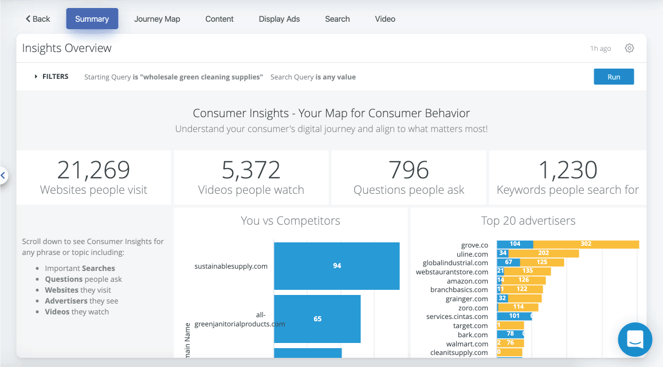
You’ll see that this example of a consumer insight report starts out by illustrating how many of the most important search terms this company’s website ranks well for in search engines compared to their competitors. It goes on to show who all is advertising for these terms - this part of the report often highlights some competitors companies don’t realize they’re competing against.
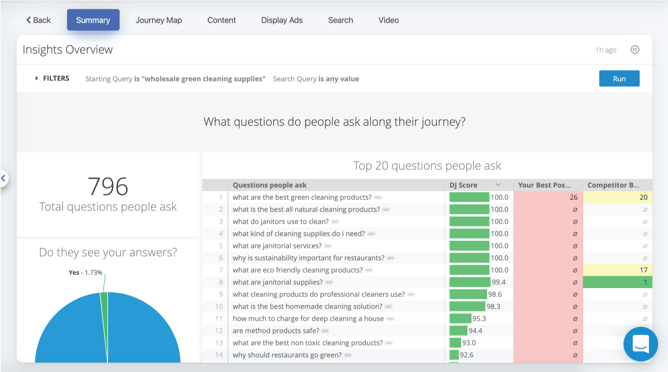
Next, you’ll see what these search terms and questions are that consumers are asking - alongside how well they rank for those terms compared to their competitors.
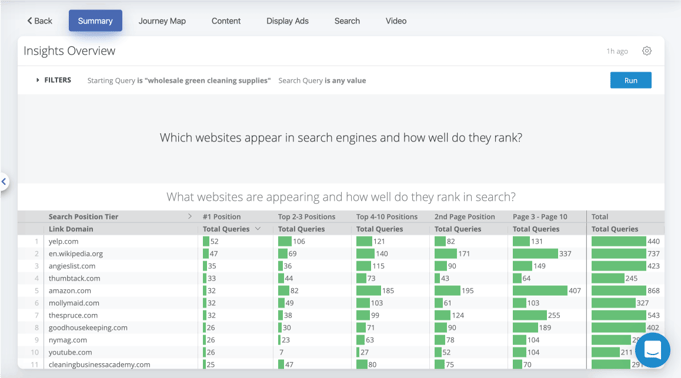
You’ll even be able to see all the websites that matter most to these consumers, and what important terms they rank for that consumers care about.
These reports go on to detail many other important consumer insights, to get one for yourself, fill out the form on the right or sign up for your free DemandJump account here.
The importance of consumer behavior research
In marketing, consumer behavior is the study of why and how the customer makes decisions about purchasing. It's an individual study that essentially tries to decode all the feelings, thoughts, and needs that go into the buying process for the individual customer.
Now that 67% of the buyer’s journey takes place online, this consumer behavior has never been easier to collect data on in order to understand. One substantial source of consumer data can be found by analyzing search behavior in search engines. But making sense of this consumer search behavior often requires the aid of more complex analysis than one could do in excel or google sheets.
That’s why leveraging machine learning platforms like DemandJump can be of such help to your consumer behavior research process. Plus, search data alone won’t give you the whole picture. The buyer journey is cross-channel, meaning that consumers navigate between search engines, websites, and social platforms before ever discovering your brand. So, analytics that have the capacity to stitch together this buyer journey are the ones that truly make a difference when trying to get ahead in today’s crowded market.
Consumer behavior research can then help companies stay competitive by informing how they tailor their marketing messages to better engage the customer. It's also widely used in order to develop and update products so that they meet current needs that aren’t being met by the existing market.
Consumer behavior combines a number of disciplines in order to bring clarity to their customer insights. Data is compiled from numerous sources that might include third party data, demographic data, and internal data from various website and social media platform analytics.
Arriving at consumer behavior conclusions often draws from several different sciences. Psychology is one of the most often cited disciplines used in this field, but other factors are equally important and might include economic studies, biology, and geographical influences. Consumer behavior is also widely influenced by trends and social pressures and recommendations.
By understanding consumer behavior, you can effectively market to and develop products that meet customer needs. These needs can also fluctuate. There are different types of consumers and marketers base their research on the targeted audience for their specific market. A consumer who is entering into a major purchase will often be far more complex and need to meet specific requirements to convert. When your products are aimed at impulse shoppers, the messaging will be completely different.
The reason that consumer behavior research is so effective is that it helps to engage individual customers by providing personalized messaging.
What is consumer insights data and where can you find it?
Data collection has long been a pivotal aspect of marketing. Consumer insights can be confusing because it’s not the data itself, but the factual information you gain about the customer based on information. There are many types of insights and not all insights will be useful for your purposes.
Marketers use data analytics and a combination of information that they gather from a variety of sources to develop insights. Their data analysis might include internal data from customer behavior on their own web properties. It often also includes wider trends and data they’ve found from sources such as third party data.
Consumer insights are important because they can help you engage your customer in a way that speaks to their current needs. To find insights, it’s important to focus first on the question you need to answer.
For instance, you might look for insights to help solve an internal problem. Perhaps sales are down for a set product. In this example, the issue is that sales have declined in one of your products. The first thing you might do is to look at customer feedback from purchasers. Reviews and other data you can gain from customers about their experience can help fuel your insights.
Another place you might want to look for information is in your competitors. If your sales are down, are customers going to a different brand or company? If that’s the case, what needs are they meeting that your brand isn’t? Are they pushing a very strong marketing campaign? Does their product have an advantage yours doesn’t?
There are several possible reasons for sales to be down on a product. It might be that your customers don’t need to replace the product often and you’re not attracting new customers at an advanced speed. It could also be that the product no longer meets the needs of the market.
In this example, you might analyze all of the data and find that your customer has found an alternative product. Looking at the most likely competitors, you find that customers are moving to a competitor who has a large presence on a particular platform. Their price points and product may meet similar needs but that’s the only discrepancy. So their marketing efforts will be the main difference.
Your insight might arrive from following that company’s marketing efforts to see where their message is meeting the customer’s needs. What you find is that the other company is offering a wealth of social proof and building their brand through a social media presence that includes customer referrals. So your insight might be that your consumer is more swayed by personal referral and social proofs than traditional marketing.
Not only are there many different techniques when it comes to collecting customer insights and many types of customer insight frameworks, there are also different types of insights themselves.
Types of consumer insights
Consumer insights are not something that you can guess at, though they are something that need both analytics and individual thought to reason out. Currently, there are many tools that you can use to pull data from various platforms and places. But, the data alone won’t be able to garner key insights to inform your marketing and business needs. Until now there have not been any complete consumer insights tools. There were tools out there that would give you examples of insights, but again, until now they were never creating consumer insights.
Key insights are insights that inform or are informed by a key performance indicator. As a key insight example, you’re looking to find out whether your messaging is engaging your customer. Your analytics tell you that there is a high click-through rate from your email campaign to your landing page, so the messaging in your email campaign is engaging for that audience. If that same audience drops out of the funnel shortly after arriving at the page, you need to find the insight that will help you understand why they didn’t follow through to conversion.
Finding that insight can be more complicated than it appears. It may in fact be the messaging on your landing page. Maybe there is something about the messaging that doesn’t engage that audience. It also may be that the target audience needs more than a few contact points with a brand before purchasing. In which case, it has little to do with your campaign and more to do with their thought process. It may also prove to be something completely outside of your internal data. You might find that this audience is looking for a lower price point.
Finding these key insights is often a combination of looking at all of the available data together and asking the right questions. There is also some assumptive reasoning that goes into developing insights. But you can test these insights out in order to prove or disprove them.
Taking a look at the above key insight example, let’s say you arrive at the insight that the consumer needs a lower cost in order to convert. So you drop the price on the product. Running a new campaign to the new sales page should yield an uptick in sales if that insight is correct.
Insights are provable. Insights should lead to a better understanding of the customer and therefore better servicing of their needs.
DemandJump created Consumer Central, a video series to inform on how to use consumer insights. Examples include Apple & Samsung, Home Depot & Lowe's, Nike, Microsoft and many more. These videos shine light on consumer insights and analytics in the platform and how to act on them.
How to gather customer insights
There are various customer insight research techniques available for marketers to use when gathering and interpreting data. Insight tools offer a wealth of ways to gather and pinpoint data in a way that makes the picture clearer for your set query. If, for example, you’re interested in finding the audience in a specific geographic location, that information can be filtered. If you’re looking for the audience in a specific geographic region that meets a certain demographic, you can filter further.
When marketers ask how to get customer insights, the first place they generally look is in the analytics tools they use such as Google Analytics, Facebook Analytics, or another cross-channel analytics platform like DemandJump. Some tools you might use often include those to help you find social mentions and the analytics available on your social media platforms, such as Facebook and Twitter. Google offers a wealth of tools that help bring value to your data and can inform insights.
Your best insights can come from customers themselves. This might include survey responses and reviews on third party sites. Compiling this data can clearly showcase what parts of the customer experience are highly prized and which areas need to be improved.
Examples of insights and how to use them
Insights don’t come solely from inside your own data sets. They often come from the world at large, first. Brand insights are becoming increasingly important as companies and even entrepreneurs build their company into a personalized brand that builds relationships rather than simply focusing on informing the public about their product details.
The customer recognizes that the brand and products or services are part of that overall feeling and persona that the brand encompasses. For brands, this is a powerful tool because great branding allows all of your products to benefit and a great product will further improve the brand.
Insights will often come from current culture and social movements. Recent events and topics that breed a wealth of emotions often inform insights in a way that can supercharge the messaging used with the insight.
If you’re looking for examples of insights that made a massive impact on the market and society in general, look no further than Always’s Like a Girl campaign. The campaign was born from one statistic, that 49% of girls avoided trying new things for fear of failure. So the campaign took this historic insult “You (insert action here) like a girl” and made it a positive. They took the power back and made that phrase reverberate as something to be proud of.
How effective was the campaign? 70% of women say the campaign changed the way they view that saying in a positive way. 60% of men agreed. That’s a pretty powerful insight that yielded a social change complete with its own hashtag and will forever be linked to the Always brand. This was a clear win for a feminine hygiene product because prior to that campaign the realistic thought was that no one would ever share an Always logo socially because it would be embarrassing.
Consumer insight strategy framework: how to plan for success
Insights can be surprising. In fact, they often are unexpected. Marketers usually agree that the best insights come as a sort of “aha” when they look at known data and connect dots that they hadn’t looked at together before. These are often known facts that just haven’t been viewed exactly that way before.
Finding your insights might be surprising but it almost never happens by accident. There is a concerted effort that goes into analyzing the data and arriving at these factual bits of information that can inform your understanding of the customer and their needs. To reach these revelations, you need to start with a consumer insights plan.
Your consumer insights strategy template is a roadmap to help organize the process and delegate responsibilities on a larger team. Developing insights isn’t as easy as sitting down and waiting for the data to tell you a story. The process starts with a clear goal in mind.
Your consumer insights strategy needs to start with your pain point or goal. What are you trying to fix or improve? What is the objective? Once you’ve answered that question, the next thing you need to decide is who will be working on the project. In most companies there will be a team dedicated to deciphering the data to arrive at key insights. This may also be an outsourced project headed by a marketing firm.
The team will discuss the timeline and determine which team members are responsible for different facets of the project. Your template will also include determining where the data will be pulled from, which will often depend partially on what your objective is. Tools and platforms will be chosen and timelines set for gathering data and analyzing the responses.
Consumer insights companies can parlay into better strategies
If you’re looking for consumer insights case study proof, there are no shortage of articles, blog posts, and major mentions of marketing innovations attached to great insights. Consumer insights articles, such as the Adidas article in Harvard Business Review, are plentiful.
The major players are all using consumer insight strategies in order to better understand their target market and also to get ahead in the wave of the digital marketplace. But the major players aren’t the only ones winning this game. Small and medium-sized companies can use these same techniques to leverage a better position in the playing field and amplify their own messaging and brand much faster than was once possible.
The role of the consumer insights analyst
Consumer insights are an important part of businesses’ ability to connect with customers. A consumer insights analyst works in the capacity to help these businesses and marketing departments make sense out of the data and arrive at the insights that can spur major changes for the brand and the customer. Consumer insights training includes understanding complex data and developing reports that can better direct business movement in product development and marketing campaigns.
To prepare for the consumer insights analyst position, most marketing professionals need a minimum of a bachelor’s degree in marketing and experience in the field. A consumer insights analyst salary averages between $63,000 and $84,000 per year.
Consumer insights jobs
The consumer insights career path continues to grow in the marketing field. Many customer insights strategist positions earn well and offer exciting work for those who are good with both analytics and the more humanities focused aspects of marketing.
A consumer insights internship can be an excellent entrance point into this field for someone still finishing their degree. Entry level consumer insights jobs often offer excellent opportunities to build skills and gain valuable experience. Consumer insights jobs salary can be moderate for an entry level position but those with more experience can expect a solid income for the field.
If you’re interested in a career in consumer insights, a bachelor’s degree is required and a few years of experience in the marketing field is often a prerequisite for new hires.
Insights Resources
Consumer InsightsConsumer Behavior
Consumer Behavior for Marketers
Consumer Insights and Analytics
Customer Insight Research Techniques
Customer Journey Map
Pillar Page Content
SEO Content Strategy
Types of Consumer Insights
Other Resources
Channel Optimization
Consumer Behavior
Consumer Insights
Consumer Insights and Analytics
Competitor Analysis Tools
Content Marketing
Content Strategy
Cross-Channel Analytics
Customer Insight Research Techniques
Customer Journey Map
Market Intelligence
Marketing Analytics Techniques
Market Research
Marketing Attribution
Opportunities of Internet Marketing
Types of Consumer Insights



